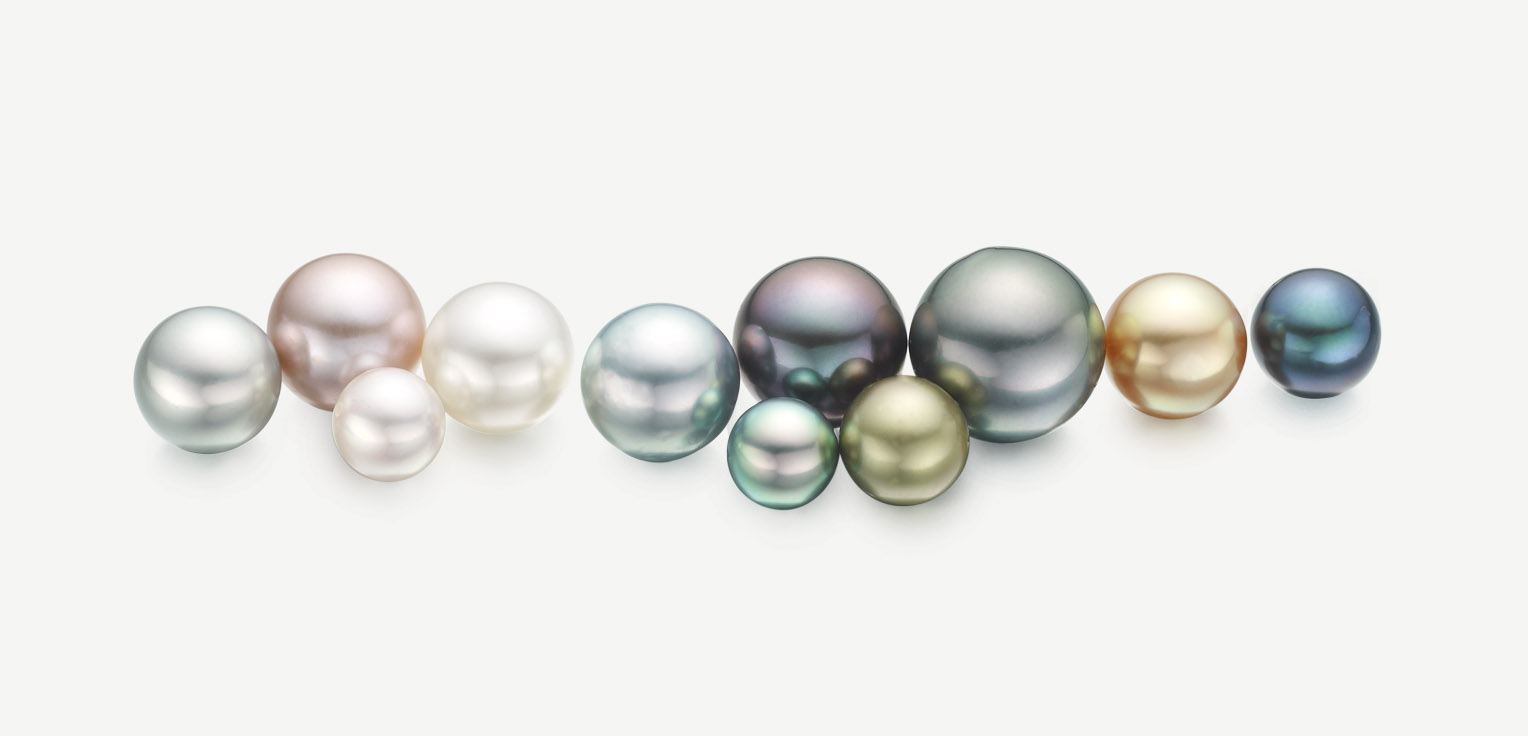Buying Guide
Grading the Qualities of Pearls

A pearl is a unique, organic gem created in a living mollusc. One pearl may vary significantly from another in its origins, characteristics and treatments.
These qualities may suit a particular style of jewellery and budget but, without a careful and consistent approach to grading, buying pearls may be confusing.
The most widely accepted system of grading worldwide for natural and cultured pearls is the Gemological Institute of America's Pearl Description System.

There are 7 different quality factors in the GIA system that we use to describe and determine the beauty of a pearl, including:
- Size
- Shape
- Colour
- Lustre or Luster
- Surface
- Nacre Quality
- Matching
Read our guide below to learn more about the 7 different value factors that are used to describe and determine the beauty of a pearl. If you would like to know about our commitment to quality, read more about Our Standards.
Size

A round pearl is measured across its diameter in millimetres.
For non-spherical, baroque and other shapes of pearls, both the length and width of the pearl is measured.
The most popular Akoya and Freshwater pearl sizes for earrings and necklaces are between 7 and 9mm in diameter.
South Sea and Tahitian pearls are typically worn between 9 and 11mm in diameter, or larger for more statement pieces.
Shape

Pearls have a variety of shapes, with the classic round and drop shapes being the most popular to wear.
The different qualities of a pearl's Shape in the GIA Pearl Description System are:
| Shape | Description |
|---|---|
| Round | Uniformly spherical |
| Near-round | Almost spherical, with some minor variations |
| Oval | Symmetrical, rounded and oblong |
| Button | Symmetrical, slightly flattened |
| Drop | Symmetrical, pear shaped |
| Semi-baroque | Irregular, not quite symmetrical |
| Baroque | A pearl with an irregular shape |
Akoya pearls tend to be most consistently round, although other nucleated saltwater pearls and increasingly Freshwater varieties can also be found in round shapes. Baroque shapes can be particularly individual and fun to wear.
Colour

One of the most unique qualities of a pearl is its colour.
At Winterson we grade the colour of the pearls in our jewellery with the GIA Pearl Description System. The table shows the different Colour characteristics that may be displayed by a pearl.
| Characteristic | Description |
|---|---|
| Bodycolour | The dominant, overall colour of a pearl |
| Overtone | Some pearls may display one or more additional overtones of colour in the reflection near the top of the pearl |
| Orient | The rainbow colours that are displayed just below the surface of a pearl, usually those of a baroque shape, as it is rotated |
The main bodycolour of a pearl will be described, with a note also being made if the pearl has an overtone colour or an iridescent rainbow effect. We will always disclose whether a pearl has been treated for colour.
Lustre

Lustre, or luster, describes the intensity and sharpness of light reflected from the surface of the pearl. The different qualities of Lustre in the GIA Pearl Description System are:
| Lustre | Reflections of Light |
|---|---|
| Excellent | Bright and sharp |
| Very Good | Bright and near sharp |
| Good | Bright, but not sharp, slightly hazy |
| Fair | Weak and blurred |
| Poor | Dim and diffused |
Of all a pearl's qualities, lustre is perhaps the most important to consider.
The Surface of a Pearl

Most pearls will have some normal surface characteristics or irregularities. The surface condition of a pearl is judged by the size, number, location, visibility and types of these blemishes.
The different qualities of Surface in the GIA Pearl Description System are:
| Surface | Description |
|---|---|
| Clean | Blemish free, minute surface marking |
| Lightly Spotted | Some minor surface irregularities |
| Moderately Spotted | Noticeable surface characteristics |
| Heavily Spotted | Obvious, possibly affecting durability |
| Poor | Dim and diffused |
The presence of these surface characteristics may add to a pearl's individual beauty but, if significant, could suggest that its durability might be affected.
Nacre Quality

Nacre is the unique layered material that gives a pearl its reflective and iridescent properties.
A pearl's beauty and value will be influenced by the thickness and crystal structure of its nacre.
The table describes the different types of Nacre Quality that are possible.
| Nacre | Description |
|---|---|
| Acceptable | No noticeable nucleus, not chalky |
| Nucleus Visible | Thin nacre, with poor pearl durability |
| Chalky | Dull appearance, with poor lustre |
All our pearls are selected for having the highest grading of nacre quality, which is described as Acceptable under the GIA's Pearl Description System.
Matching

Matching describes the uniformity of appearance of two or more pearls that have been used in jewellery, for example in necklaces, bracelets or earrings.
The consistency of the other six Qualities should be considered.
| Matching | Description |
|---|---|
| Excellent | Pearls are uniform in appearance and drilled centrally |
| Very Good | Some minor variations in uniformity |
| Good | Minor variations in uniformity |
| Fair | Noticeable variations in uniformity |
| Poor | Very noticeable variations in uniformity |
